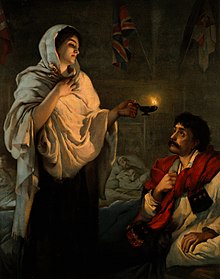 The early life of Florence Nightingale, as portrayed by Kay Francis, is the subject of The White Angel (1936). The film follows Nightingale's announcement of her intention to be a nurse, to her training at the Deaconess Institute in Kaiserwerth (Germany), to her work in Scutari during the Crimean War.
The early life of Florence Nightingale, as portrayed by Kay Francis, is the subject of The White Angel (1936). The film follows Nightingale's announcement of her intention to be a nurse, to her training at the Deaconess Institute in Kaiserwerth (Germany), to her work in Scutari during the Crimean War.In an era where nursing is a respected profession, it is important to emphasize the impact of Florence Nightingale in the creation OF the profession. Nightingale horrified her well-to-do family when she told them that she had a calling to become a nurse. The job that was nursing in England during this period involved hiring slatterns to primarily sit in hospitals and drink. Hospitals were NOT a place you wanted to be - they were filthy, and the "nurses" did little to help the situation. But Nightingale changed all that, first with her work in Scutari, and then with the books and reports she published after her return to England. This film, while rather loose in its faithfulness to the story of Nightingale's life, emphasizes the spirit of the adoration that was heaped upon Miss Nightingale during and after the War.
It's interesting that The New York Times, though they liked Kay Francis, is disturbed the the "reverential tone" of the film. Yes, Ms. Francis does sometimes seem to be "striving to live up to Longfellow's 'Lady With the Lamp.'", but that is a hard image to lose. Below is a copy of the film's poster, alongside an 1891 painting. Tthe film mirrors the idolization of Ms. Nightingale that came down from the 1850s. As referenced in the film, Henry Wadsworth Longfellow did write Santa Filomena (1857) about Miss Nightingale. To a 21st century mind, this adoration can be off-putting, but it is well within the attitudes that prevailed during Miss Nightingale's life.
 |

|
What the screenplay DOESN'T do is to add a phony romantic subplot. Charles Cooper (Donald Woods) professes his love for Florence, but she has absolutely no interest in him. In his biography, Eminent Victorians (which the film credits as their key source), Lytton Strachey notes that at one point, Nightingale found someone she considered to be "a desirable young man", but whom she ultimately rejected in preference to "A profession, a trade, a necessary occupation, something to fill and employ all my faculties, I have always felt essential to me..." Woods fills that bill nicely; and Francis is excellent at displaying affection, but not romantic love.
It was interesting to see Donald Crisp fill the role of the overtly hostile Dr. Hunt. Crisp shows much more of the imperious tone he would display in The Uninvited, but NONE of the affection and kindness. This was a Donald Crisp we were unused to, though with 170 film and television credits, Crisp has played just about everything. His film career began in the silent era (he played Ulysses S. Grant in Birth of a Nation); prior to that, he had served as a trooper in the Boer Wars. He studied with D.W. Griffith to become a director and during the silent and early sound eras, he directed 72 films. Ultimately, he found the work trying, and returned to acting exclusively. He appeared in some of the truly great films: Wuthering Heights (1939), How Green Was My Valley (for which he won the Academy Award as Best Supporting Actor of 1941), Lassie Come Home (1943), and National Velvet (1944). Married and divorced twice, Crisp worked until 1963 - his last role was as Grandfather Spencer in Spencer's Mountain. He died in 1974, at the age of 91.
It's unusual for Kay Francis to not spend an entire film in eye-catching clothing, but her few lovely gowns are still designed by Orry-Kelly. Even with such an interesting subject, this movie still didn't do well at the box office (see this TCM article). As mentioned, it is not Ms. Francis' acting tht is the problem, but perhaps audiences so used to seeing her in melodramas were not prepared to watch her as an actual historical character.
This was not the first time Nightingale's life had been portrayed. During the silent era, Julia Swayne Gordon would portray her in The Victoria Cross (1912), and Elisabeth Risdon starred in Florence Nightingale (1915). After our film, the story would be attempted again - this time by the British in the 1951 film The Lady with the Lamp starring Anna Neagle. And, in 1985, a television movie with Jaclyn Smith was released. Though the 1951 film is probably the best of the bunch, we think this movie is worth your time, most especially for Ms. Francis' excellent performance. Here is a trailer to give you a taste:
No comments:
Post a Comment
Thanks for your interest in this blog. Your comments will be moderated to minimize spam to the website. Thanks for understanding.